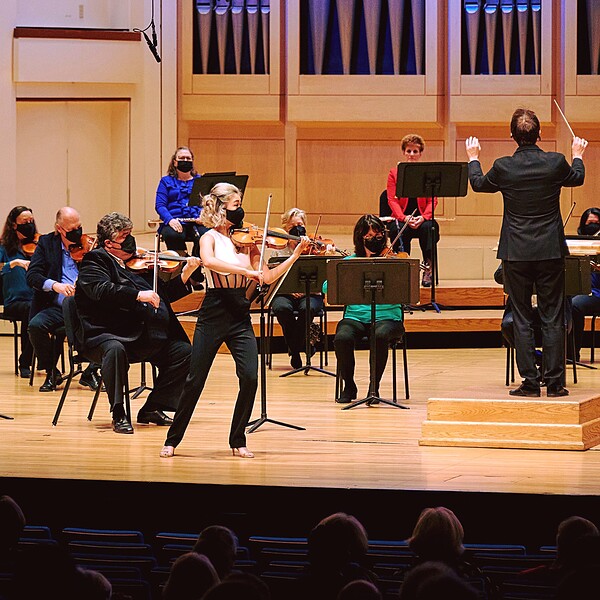Review
Charlotte Symphony Comes Back with Violinist Simone Porter and Live Audience

Charlotte Symphony Comes back with Violinist Simone Porter & Live Audience
By Timothy H. Lindeman
June 5, 2021 - Charlotte, NC
The Charlotte Symphony, led by resident conductor Christopher James Lees, performed works by W.A. Mozart and Ottorino Respighi Saturday night. The concert opened with guest violinist Simone Porter performing the former's Violin Concerto No. 3 in G, K.216.
Mozart wrote at least five violin concertos, all before he was 25, and all in three movements: fast-slow-fast. The third concerto has the subtitle, "Straßburger-Concert," most likely because the third movement includes a popular tune of the time known as "The Straßburger."
The evening opened with Lees giving introductory remarks, stating that this was the first concert the CSO has performed before a live audience in more than 13 months. He asked the viewers to pay attention to the amount of energy that comes with live performances.
It was indeed nice to have an audience greet concertmaster Calin Ovidiu Lupanu with hearty applause. The audience also warmly welcomed conductor Lees and soloist Porter, certainly a welcome transformation from the silent, no-live-listener concerts that have characterized streamed performances for more than a year.
The orchestra jumped into the opening with good spirits and energy, exemplifying the effervescent mood of the first movement. Porter picked up the dynamism, and the electricity was palpable. Perhaps the downbeats were a bit too accented by the orchestra, but not enough to distract from the general buoyancy. Porter's authority of the score was never in question – from soaring lyricism to the dramatic moments in the each of the movements and in the cadenzas (with some pyrotechnics thrown in for good measure) – all was well-balanced.
In the second Adagio movement, Porter wove wonderful threads of melody through the fabric of the music, sometimes so tenderly that even the very soft playing of the orchestra overshadowed her. The lively finale begins with a buoyant tune presented by the orchestra, which is picked up by the soloist; the audience hears this tune several times through the course of the Rondo.
Throughout, Porter displayed fine discipline coupled with passion. Lees, for his part, kept close watch on the soloist and ensured that the orchestra and violinist performed with a unified vision. Several in the socially distanced audience responded with a standing ovation, calling back the conductor and soloist.
Between the Mozart and the Respighi, Lees returned to comment on the Mozart and praise the soloist, who "transformed the piece into pure poetry." He also provided some introductory remarks about Respighi.
All three of Respighi's Ancient Airs and Dances suites are loosely transcribed from original lute pieces. The Third Suite, according to the program notes written by Ken Meltzer, contains "orchestral arrangements of Italian and French lute music from the 16th and 17th centuries. Respighi found most of his material from lute pieces transcribed for the guitar and published by the Italian musicologist, Oscar Chilesotti."
The first movement, "Italiana," is upbeat and tuneful. Sometimes I wished for more melody from the first violins, but perhaps this is a recording issue. In "Arie di corte" (Airs of the court), the violas take the lead with the doleful first tune (which returns at the end) in this multi-sectioned movement. Slower, more introspective parts are interspersed with lively passages.
"Siciliano" is also slow with a lilting rhythm, although a faster moving section provides contrast before the rather sad opening tune returns. The finale, a set of variations over a repeated figure (a passacaglia), is also a rather sturdy, somber affair, but faster variations breathe energy into the movement before the dramatic conclusion.
Lees confidently and artistically led the orchestra through this fifteen-minute "contemporary" arrangement of "early" music. As one critic stated, "If ever there was music that will help you get through those sleepless nights, Respighi's Three Suites of Ancient Airs and Dances has got to be it." Agreed.